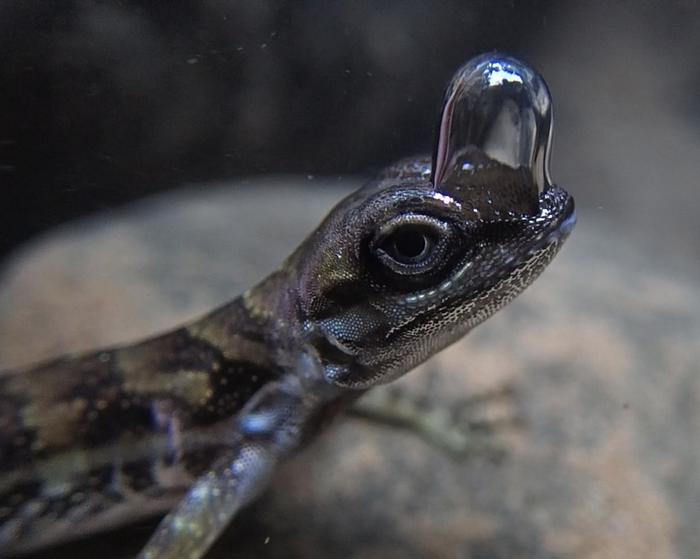Summary: Water anoles, a semi-aquatic lizard species, can create air bubbles over their nostrils to breathe underwater and avoid predators, according to new research from Binghamton University.
Estimated reading time: 5 minutes
In a fascinating display of natural ingenuity, scientists have discovered that a species of semi-aquatic lizard employs a unique “scuba-diving” technique to escape danger. Water anoles, found in the tropical forests of southern Costa Rica, can create and use air bubbles to breathe underwater, allowing them to stay submerged for extended periods and evade predators.
The groundbreaking research, conducted by Lindsey Swierk, an assistant research professor of biological sciences at Binghamton University, State University of New York, sheds light on this previously unknown survival mechanism. The study, published in Biology Letters, demonstrates that these lizards can remain underwater for significantly longer periods when using their bubble-breathing technique.
The Bubble Breathing Phenomenon
Water anoles have been observed diving underwater and creating a bubble over their heads when threatened. While this behavior had been documented before, its functional role remained unclear until now.
“We know that they can stay underwater for a really long time. We also know that they’re pulling oxygen from this bubble of air,” said Swierk. “We didn’t know whether there was actually any functional role for this bubble in respiration. Is it something that lizards do that is just a side effect of their skin’s properties or a respiratory reflex, or is this bubble actually allowing them to stay underwater longer than they would, say, without a bubble?”
To investigate the purpose of this bubble, Swierk designed an experiment that involved applying a substance to the lizards’ skin to prevent bubble formation. The hydrophobic nature of lizard skin typically allows air to adhere tightly, facilitating bubble creation. By applying an emollient to the skin, Swierk disrupted this process.
The results were striking. Lizards in the control group, able to form bubbles normally, could stay underwater 32% longer than those with impaired bubble formation. This finding provides the first experimental evidence of the adaptive significance of bubble breathing in these lizards.
Underwater Refuge from Predators
The ability to stay submerged for extended periods serves as a crucial survival mechanism for water anoles. As Swierk colorfully described, “Anoles are kind of like the chicken nuggets of the forest. Birds eat them, snakes eat them.” By diving underwater and remaining still, these lizards can effectively escape many of their natural predators.
The study revealed that water anoles can stay submerged for at least 20 minutes, though the actual duration may be even longer. This extended dive time, coupled with their underwater camouflage, provides a significant advantage in evading threats.
Future Research and Implications
The discovery of this bubble-breathing adaptation opens up new avenues for research. Swierk and her team are now investigating whether water anoles use their bubbles as a form of physical gill, similar to some aquatic insects. This phenomenon, if confirmed, could have implications for understanding vertebrate adaptations to aquatic environments.
Additionally, this research could inspire innovations in bioinspired materials and spark public interest in science. Swierk noted the potential for connecting with people who enjoy activities like scuba diving and freediving, highlighting the parallels between human underwater exploration and natural evolutionary adaptations.
“Even in animals that seem commonplace – you’re always finding new things,” Swierk remarked, emphasizing the ongoing potential for discovery in the natural world.
Quiz:
- What species of lizard was studied in this research?
- How much longer could lizards stay underwater when able to form bubbles compared to those without?
- What substance did researchers apply to prevent bubble formation in the experiment?
Answers:
- Water anoles
- 32% longer
- An emollient
Further Reading:
Glossary of Terms:
- Water anoles: A species of semi-aquatic lizard found in tropical forests of southern Costa Rica
- Hydrophobic: Tending to repel or fail to mix with water
- Emollient: A substance that softens or soothes the skin
- Physical gill: A mechanism used by some aquatic insects to extract oxygen from water using an air bubble
- Bioinspired materials: Materials or technologies inspired by biological systems or processes
Enjoy this story? Get our newsletter! https://scienceblog.substack.com


